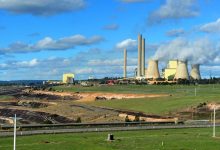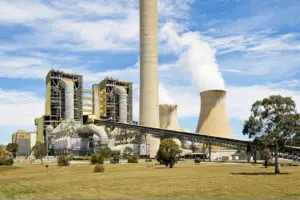The massive Loy Yang A brown coal generator – if you believe its owners AGL – is supposed to be the last coal generator standing in Australia’s main electricity grid.
AGL plans to keep it operating for another three decades, closing it on its 50th birthday way out in 2048, if future emissions reduction targets allow it. But if the plant keeps on breaking down like it is now, and proves expensive to maintain, as some analysts are suggesting, then it might be struggling to last half that time.
And therein lies the problem of depending on Australia’s ageing and increasingly unreliable brown coal generators to keep the lights on, or even keep prices down. The current fleet of coal generators is looking increasingly incapable of doing either, and Australia must find a path, and a plan, to put the long-term clean energy transition into place now.
Good luck with that with the current Coalition government, still in a state of denial about both emissions and the competition and performance of renewables and storage.
The government remains dependent on cross-benchers in the Senate, such as the climate denying One Nation and others who think it’s a good idea to build a new coal generator, a view shared by many of its own MPs and ministers who have held hostage any attempts at forging a half decent climate and energy policy for the past six years.
Late on Friday, a long time after the market closed, AGL announced that the second unit of the Loy Yang A generator in Victoria’s Latrobe Valley, which broke down on May 18, could be out of action for another seven months because of the difficulties replacing the stator and rotor components, and because the damage may be wider than thought.
“AGL now expects it may take until December 2019 to return the Unit to service and ensure its ongoing reliability,” it said in its statement. “This duration of repair reflects the unique original technical design specifications of the Unit and the extent of damage.”
 The impact on Australia’s main grid may not be substantial, assuming that the unit does get back into service by December as planned. The absence of the unit will likely force prices higher than they would otherwise be, delivering potential revenue gains to all generators, brown, black or green.
The impact on Australia’s main grid may not be substantial, assuming that the unit does get back into service by December as planned. The absence of the unit will likely force prices higher than they would otherwise be, delivering potential revenue gains to all generators, brown, black or green.
(See also AGL looks to future of energy with multi-billion dollar telco play).
But the threat to grid security will likely only occur if there are further problems and further delays that extend into summer.
Victoria found out the summer past the cost of multiple breakdowns of coal generators, when more than a third of its capacity was absent when it was needed most.
That put wholesale prices to the maximum level of more than $14,000/MWh, and forced the Australian Energy Market Operator to impose rolling blackouts on up to 200,000 consumers when it could not find enough capacity to match soaring demand on January 25.
In 2018, there were more than 135 major breakdowns from coal and gas plants, according to The Australia Institute, and on a capacity basis, the brown coal generators in Victoria were the worst performing.
On the face of it, increased production from its remaining units (in NSW and Liddell and Bayswater) and higher prices might be good for AGL, and the likes of Snowy Hydro, but AGL is likely to have already hedged its position, so it may not be such good news.
Indeed, AGL currently expects the impact on next year’s profit to be between $60 million and $100 million. But it could be more. “Detailed assessment of the required repair process and likely financial impact is continuing,” it says.
The market is not convinced that everything will go OK this summer. It is pricing peaks in Victoria at $196/MWh and the “baseload” price at more than $105/MWh, according to analysts at Morgan Stanley.
The broader impact is also significant. Market analysts suggest that AGL might have to increase the amount of money it spends on maintaining Loy Yang and that will likely apply to other owners of brown and black coal generators in Australia, particularly as the stresses compound with the increased share of renewables and the soaring temperatures of summer.
Already, AEMO expects all coal generation to leave the main grid by 2048, and nearly two-thirds of it by 2040. But it also acknowledges that it could happen quicker than that, and has been urged by the industry to take that into account when it delivers its updated Integrated System Plan – a 20-year blueprint on how to prepare for the energy transition – later this year.
Last week, AEMO released initial modelling prepared by Aurora, which pointed to early retirement from the NEM of some coal assets that are relatively more vulnerable to early closure.
These include Vales Point B in NSW, which could be undermined by increased renewables production from South Australia once a new inter-connector is built. Little wonder that part owner Trevor St Baker has his hand out for government funds and is noisily railing against the growing share of wind and solar in the grid.
Another coal generator under peril from renewables is Yallourn, which is scheduled for closure in the early 2030s, but which could shut at least one of its units a decade earlier because of growing reliability issues, and the impact of more wind and solar into the grid. Gladstone in Queensland is also vulnerable.
“The primary driver of declining profitability is increased competition from renewables and increased interconnection which erodes both coal asset load factors and time weighted average wholesale prices,” Aurora says.
As Aurora notes, and AEMO has made clear, replacing coal-fired generation at lowest cost will involve a portfolio of “utility-scale renewable generation, storage, distributed energy resources, flexible thermal capacity, and transmission.”
No mention of new coal-fired generators, which would likely cost at least double the renewable and storage competitor, despite the insistence by One Nation and their like-minded colleagues in the Coalition who insist new coal power would lower prices.
Even extending the life of Liddell, as energy minister Angus Taylor is still threatening to enforce through his “big stick” legislation, is likely to cost nearly double the alternatives cited by the government’s own Snowy Hydro and the likes of Infigen Energy. Namely: wind and solar backed up by “firm generation” that is not imperilled by searing heat.








